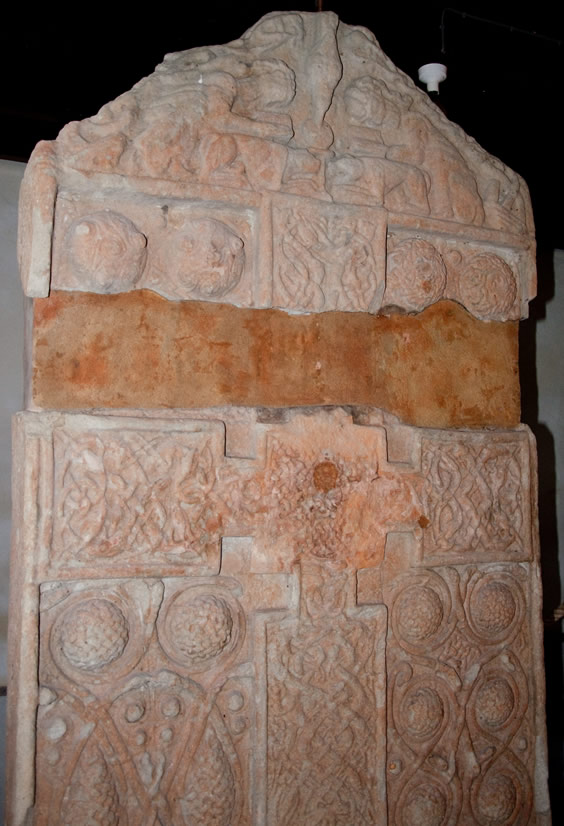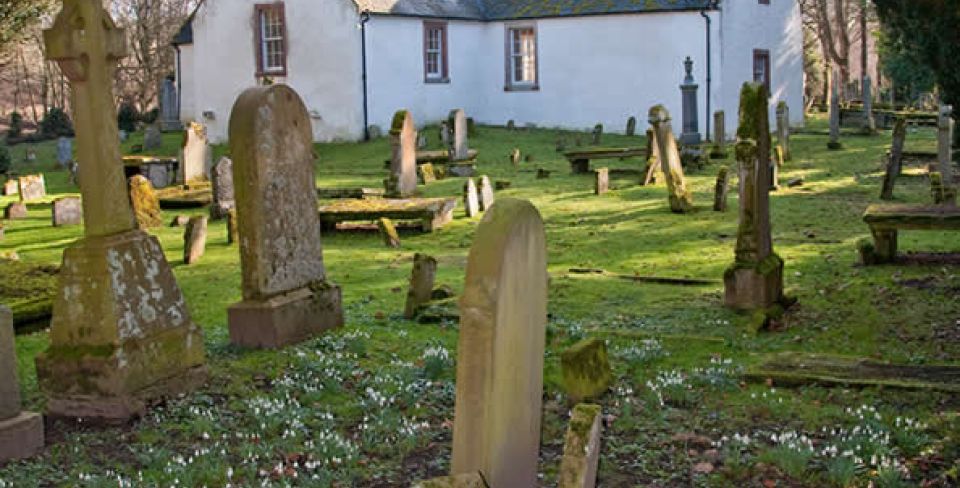8.4 Nigg Stone
The Nigg Stone is one the finest carved Pictish stones. It was carved around 800AD – or perhaps earlier – and is covered in Christian symbols
From the details of this carved stone, it is clear that there were close links between monks living in Nigg and Portmahomack, and the monasteries in Iona and Northumbria.

The designs on this stone also appear on illuminated manuscripts made by monks living in those two places.
The patterns and symbols on the Nigg stone are very similar to the decorations found in the Book of Kells, the great illuminated book started by Colmcille’s monks in Iona and finished by them at Kells in Ireland.
There are also strong links with the St Andrews Sarcophagus now kept in St Andrew’s Cathedral museum, Fife.
Nigg is one of three standing stones on the east coast of Tarbat Ness. Other stones are further north in the village at Shandwick and at Hilton of Cadboll.
The Nigg stone is kept inside the parish church. It is thought that the stone might have been kept under cover in the past because it is in such good condition.
Yet parts of the stone are missing and the back is badly worn.
The stone has been dated to about 800 but may even be earlier. It is decorated with Christian symbols and would have been used during religious ceremonies – perhaps as a focus for preaching or mass would have been performed in front of it.
The top of the stone tells the story of the meeting of St Paul and St Anthony as told in Jerome’s Life of St Paul. Paul and Anthony are seen as the fathers of monasticism and have a particularly strong association with monks and the monastic life.
St Paul was a hermit monk. Every day a raven brought him a piece of bread to eat. On the day that St Anthony visited St Paul, the raven brought a whole loaf of bread for the two saints to share.
The stone depicts the moment when the raven arrives with the bread.
The men are kneeling and saying mass from the books that they are holding. The bread has a small piece missing as the raven places it on a chalice.
The carving is full of fine detail – the saints’ beards and hair, the bread with a corner missing, the palm trees at the edge of the scene.
The saints appear to be in profile but, when seen from a kneeling position, the other side of both saints’ faces is visible.
The lions – which the saints appear to lean on – represent the moment when St Anthony returns to visit St Paul and finds that he has died.
Two lions come out of the desert to help St Anthony to dig a grave for St Paul.

Snakes appear in many places on the stone. What might appear to be balls of twine are actually piles of intertwined snakes with one snake emerging from each ball – or boss – and interlacing with others.
Serpents are important Christian symbols. They are associated with evil from the story of Adam and Eve but they are also symbols of resurrection as, according to medieval legend, they spend three days underground and then re-emerge having shed their old skin.
They are also seen as wise – a serpent protects its head when under attack which is a metaphor for protecting ones mental processes.
Like other Pictish stones, the patterns are not symmetrical but repeat certain symbols – key patterns, spiral ornaments, bosses and interlace. These patterns are very similar in style and distribution to those found in the Book of Kells, started by the monks of Iona and completed by them after they abandoned the island and moved to Kells in Ireland.
The back of the stone is decorated with an eagle symbol and hunting scenes. The figures tell the story of how David killed a lion in order to save a lamb in his flock.
Tarbat Ness
- 8.1 Tarbat Discovery Centre, Portmahomack
Between 1994 and 2007 archaeologists excavated an area around the church of St Colman at Portmahomack on the tip of Tarbat Ness. They discovered an extensive monastic settlement dating from the late 6th century. The Tarbat Discovery Centre tells the story of this Christian settlement and its re-discovery by archaeologists....
- 8.2 Hilton of Cadboll
Tarbat Ness is home to a number of standing stones which reflect the artistic skill and Christian faith of the Pictish people who carved them. The stones may have marked the boundary of the lands controlled by the monastery at Portmahomack. The cross-slab at Hilton of Cadboll is a replica...
- 8.3 Shandwick
The cross-slab stone at Shandwick is covered with Christian symbols. This is an expression of Pictish Christianity rather than being a stone which combines pagan and religious designs. There were probably a number of monastic settlements along this coast under control of the large monastery at nearby Portmahomack. The stone...
- 8.4 Nigg Stone
The Nigg Stone is one the finest carved Pictish stones. It was carved around 800AD - or perhaps earlier - and is covered in Christian symbols From the details of this carved stone, it is clear that there were close links between monks living in Nigg and Portmahomack, and the...
- 8.5 Craig Phadraig
Craig Phadraig is a wooded hill on the edge of Inverness. Follow the path up the hill to discover the possible remains of King Brude’s fort. Colmcille’s biographer Adomnán describes the saint visiting King Brude, the Pictish king, at his fort somewhere near the River Ness - possibly here at...
- 8.6 Other Pictish Stone Sites North of Inverness
Other Pictish stone sites Explore the history of the Picts along the east coast from Inverness northwards. The Highland Pictish Trail Trail highlighting 17 sites with Pictish stones, ranging from Inverness to Dunrobin near Golspie. A Catalogue of Pictish Stones at Inverness Museum and Art Gallery The catalogue lists all...










Bòrd na Gàidhlig
Great Glen House
Leachkin Road
Inverness
Scotland, IV3 8NW
(+44) 01463 225454
colmcille@gaidhlig.scot
Colmcille
Foras na Gaeilge, 2-6 Queen Street
Belfast
Northern Ireland
BT1 6ED
(+44) 028 9089 0970
colmcille@forasnagaeilge.ie
Colmcille
Foras na Gaeilge, An Chrannóg
Na Doirí Beaga
Gaoth Dobhair
Donegal, Ireland. F92 EYT3
(+353) 074 9560113
colmcille@forasnagaeilge.ie


